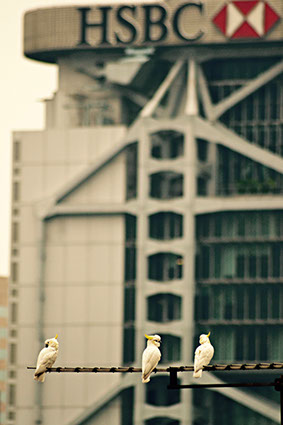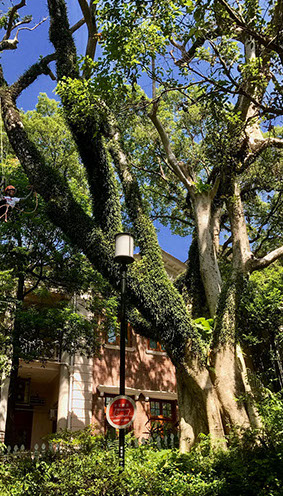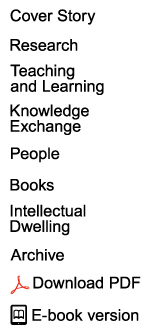The Yellow-crested Cockatoo is a common sight in our city sprawl, flying past office windows, perched on balconies – in particular on Hong Kong Island between Happy Valley and Pokfulam. Yet it is not a native bird nor is it usually a city slicker, and in its homeland this distinctive bird is critically endangered.
Dr Luke Gibson, of HKU’s School of Biological Sciences, said: “These cockatoos are what is termed an ‘introduced species’, not native to Hong Kong but brought in by humans. Most are probably pets that have been released, either on purpose or because they have escaped into the wild, where they have been able to survive and breed.”
Dr Gibson became interested in the species in May, 2015 when he read a news story about the interception of a shipment of 23 Yellow-crested Cockatoos from Indonesia. Each bird had been stuffed into a plastic water bottle, and the collection was being shipped out of Indonesia as part of the illegal pet trade.
“I was shocked to learn that a species so common here is critically endangered due to ongoing poaching in its native range in Indonesia. Although the introduced population in Hong Kong remains relatively stable, the native population in Indonesia continues to decline. It raised the obvious question: Can one situation help the other? Can a successful introduced population provide hope for its relatives threatened in their native habitat?”

![]() I was shocked to learn that a species so common here [in Hong Kong] is critically endangered due to ongoing poaching in its native range in Indonesia.
I was shocked to learn that a species so common here [in Hong Kong] is critically endangered due to ongoing poaching in its native range in Indonesia. ![]()
Dr Luke Gibson
Globally threatened
The situation is not unique to the Yellow-crested Cockatoo. Dr Gibson and Dr Ding Li Yong from BirdLife International Asia recently completed a study in which they identified 49 globally-threatened species – that is, those listed by the International Union for Conservation of Nature as Vulnerable, Endangered, or Critically Endangered – which have established populations outside their native distribution. The study, published recently in Frontiers in Ecology and the Environment, includes amphibians, reptiles, mammals, insects and plants, as well as birds including the Yellow-crested Cockatoo.
Dr Gibson’s research now, being undertaken by PhD student Ms Astrid Andersson and joined by
Dr Caroline Dingle, aims to compare introduced cockatoos in Hong Kong, which number approximately 200 or about 10 per cent of the total population globally, with native cockatoos in Indonesia. They will concentrate on investigating what, besides poaching, is causing such rapid population declines in the native range – by making comparisons between external factors in Hong Kong and Indonesia.
“Hong Kong has a population of seven million people, the Pearl River Delta has around 65 million, making these among the most densely populated areas in the world,” said Dr Gibson. “That density has taken a huge toll on the natural environment. All of Hong Kong’s forest is secondary – forests were cleared during WWII – and that has had a great impact on the biodiversity. While many species have disappeared, the Yellow-crested Cockatoo is a different story.”
Most of the cockatoo population is situated at the border between urban areas and the forest, and the team has found a link between the number of large trees and trees with cavities suitable for nesting and cockatoo population size. Many such trees are found in the city parks, which accounts for at least some of the birds’ urban habitat.
“We will be comparing behaviour, species interactions and threat levels for both the native and introduced populations,” said Ms Andersson. “This may provide insight into the adaptability and risks for this critically endangered species, and help inform conservation efforts going forward.”
On the other side of the coin, she is also currently observing whether the Yellow-crested Cockatoo threatens any native species in Hong Kong. Do they harm trees or compete with native birds for nesting places or food, for example? When she has completed her studies here,
Ms Andersson plans to spend three months each year replicating this research in Indonesia, to study interactions with predators and competitors in their native habitats.
When these studies are complete, the team may be able to consider further questions such as whether the reintroduction of the species to Indonesia and East Timor could help buffer the populations in its native range.
“Before this could happen there is a legal minefield to navigate, both in Hong Kong and in Indonesia,” said Dr Gibson. “We would need the support of many different people and bodies before the reintroduction could happen. And before that, we would need to be absolutely sure the cockatoos would be better protected in their native country than they had been previously.”
It seems the fate of this critically endangered species might lie in the introduced population, with their raucous calls constantly reminding us of their presence here in Hong Kong.
-crop-u14441.jpg?crc=240308381)
City Slickers
In stories of animal extinction, the modern world and in particular urban developments wiping out natural habitats are often the villains of the piece. But in the case of the Yellow-crested Cockatoo, Hong Kong’s urban sprawl may be playing a protective role.
Next
Back
Hong Kong is home to critically endangered Yellow-crested Cockatoo.
Dr Luke Gibson’s research assistant Banson Leung, climbing a tree to install a camera near an active cockatoo nest next to HKU’s Main Building to record their nesting behaviour.
Yellow-crested Cockatoo in Hong Kong.
(Courtesy of Peter and Michelle Wong)




